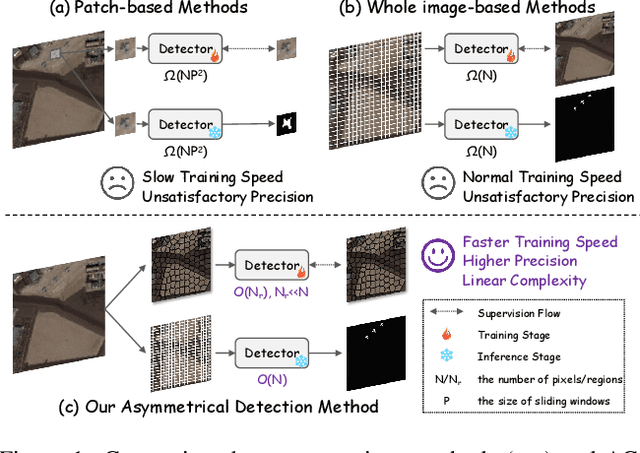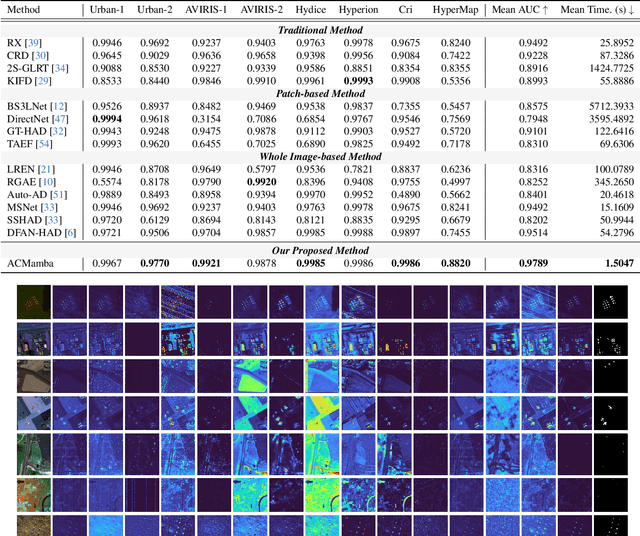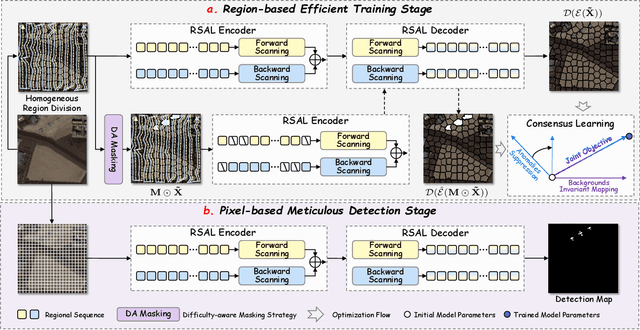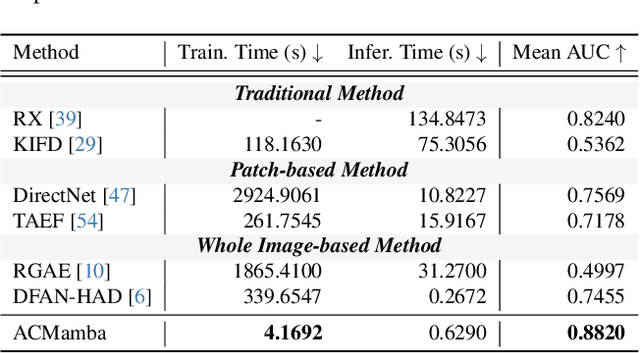Yifei Zhang
Insight Rumors: A Novel Textual Rumor Locating and Marking Model Leveraging Att_BiMamba2 Network
Aug 18, 2025Abstract:With the development of social media networks, rumor detection models have attracted more and more attention. Whereas, these models primarily focus on classifying contexts as rumors or not, lacking the capability to locate and mark specific rumor content. To address this limitation, this paper proposes a novel rumor detection model named Insight Rumors to locate and mark rumor content within textual data. Specifically, we propose the Bidirectional Mamba2 Network with Dot-Product Attention (Att_BiMamba2), a network that constructs a bidirectional Mamba2 model and applies dot-product attention to weight and combine the outputs from both directions, thereby enhancing the representation of high-dimensional rumor features. Simultaneously, a Rumor Locating and Marking module is designed to locate and mark rumors. The module constructs a skip-connection network to project high-dimensional rumor features onto low-dimensional label features. Moreover, Conditional Random Fields (CRF) is employed to impose strong constraints on the output label features, ensuring accurate rumor content location. Additionally, a labeled dataset for rumor locating and marking is constructed, with the effectiveness of the proposed model is evaluated through comprehensive experiments. Extensive experiments indicate that the proposed scheme not only detects rumors accurately but also locates and marks them in context precisely, outperforming state-of-the-art schemes that can only discriminate rumors roughly.
Discovery Learning accelerates battery design evaluation
Aug 09, 2025Abstract:Fast and reliable validation of novel designs in complex physical systems such as batteries is critical to accelerating technological innovation. However, battery research and development remain bottlenecked by the prohibitively high time and energy costs required to evaluate numerous new design candidates, particularly in battery prototyping and life testing. Despite recent progress in data-driven battery lifetime prediction, existing methods require labeled data of target designs to improve accuracy and cannot make reliable predictions until after prototyping, thus falling far short of the efficiency needed to enable rapid feedback for battery design. Here, we introduce Discovery Learning (DL), a scientific machine-learning paradigm that integrates active learning, physics-guided learning, and zero-shot learning into a human-like reasoning loop, drawing inspiration from learning theories in educational psychology. DL can learn from historical battery designs and actively reduce the need for prototyping, thus enabling rapid lifetime evaluation for unobserved material-design combinations without requiring additional data labeling. To test DL, we present 123 industrial-grade large-format lithium-ion pouch cells, spanning eight material-design combinations and diverse cycling protocols. Trained solely on public datasets of small-capacity cylindrical cells, DL achieves 7.2% test error in predicting the average cycle life under unknown device variability. This results in savings of 98% in time and 95% in energy compared to industrial practices. This work highlights the potential of uncovering insights from historical designs to inform and accelerate the development of next-generation battery technologies. DL represents a key advance toward efficient data-driven modeling and helps realize the promise of machine learning for accelerating scientific discovery and engineering innovation.
Resource-Limited Joint Multimodal Sentiment Reasoning and Classification via Chain-of-Thought Enhancement and Distillation
Aug 07, 2025Abstract:The surge in rich multimodal content on social media platforms has greatly advanced Multimodal Sentiment Analysis (MSA), with Large Language Models (LLMs) further accelerating progress in this field. Current approaches primarily leverage the knowledge and reasoning capabilities of parameter-heavy (Multimodal) LLMs for sentiment classification, overlooking autonomous multimodal sentiment reasoning generation in resource-constrained environments. Therefore, we focus on the Resource-Limited Joint Multimodal Sentiment Reasoning and Classification task, JMSRC, which simultaneously performs multimodal sentiment reasoning chain generation and sentiment classification only with a lightweight model. We propose a Multimodal Chain-of-Thought Reasoning Distillation model, MulCoT-RD, designed for JMSRC that employs a "Teacher-Assistant-Student" distillation paradigm to address deployment constraints in resource-limited environments. We first leverage a high-performance Multimodal Large Language Model (MLLM) to generate the initial reasoning dataset and train a medium-sized assistant model with a multi-task learning mechanism. A lightweight student model is jointly trained to perform efficient multimodal sentiment reasoning generation and classification. Extensive experiments on four datasets demonstrate that MulCoT-RD with only 3B parameters achieves strong performance on JMSRC, while exhibiting robust generalization and enhanced interpretability.
Cross-modal RAG: Sub-dimensional Retrieval-Augmented Text-to-Image Generation
May 29, 2025Abstract:Text-to-image generation increasingly demands access to domain-specific, fine-grained, and rapidly evolving knowledge that pretrained models cannot fully capture. Existing Retrieval-Augmented Generation (RAG) methods attempt to address this by retrieving globally relevant images, but they fail when no single image contains all desired elements from a complex user query. We propose Cross-modal RAG, a novel framework that decomposes both queries and images into sub-dimensional components, enabling subquery-aware retrieval and generation. Our method introduces a hybrid retrieval strategy - combining a sub-dimensional sparse retriever with a dense retriever - to identify a Pareto-optimal set of images, each contributing complementary aspects of the query. During generation, a multimodal large language model is guided to selectively condition on relevant visual features aligned to specific subqueries, ensuring subquery-aware image synthesis. Extensive experiments on MS-COCO, Flickr30K, WikiArt, CUB, and ImageNet-LT demonstrate that Cross-modal RAG significantly outperforms existing baselines in both retrieval and generation quality, while maintaining high efficiency.
Beyond Linearity: Squeeze-and-Recalibrate Blocks for Few-Shot Whole Slide Image Classification
May 21, 2025Abstract:Deep learning has advanced computational pathology but expert annotations remain scarce. Few-shot learning mitigates annotation burdens yet suffers from overfitting and discriminative feature mischaracterization. In addition, the current few-shot multiple instance learning (MIL) approaches leverage pretrained vision-language models to alleviate these issues, but at the cost of complex preprocessing and high computational cost. We propose a Squeeze-and-Recalibrate (SR) block, a drop-in replacement for linear layers in MIL models to address these challenges. The SR block comprises two core components: a pair of low-rank trainable matrices (squeeze pathway, SP) that reduces parameter count and imposes a bottleneck to prevent spurious feature learning, and a frozen random recalibration matrix that preserves geometric structure, diversifies feature directions, and redefines the optimization objective for the SP. We provide theoretical guarantees that the SR block can approximate any linear mapping to arbitrary precision, thereby ensuring that the performance of a standard MIL model serves as a lower bound for its SR-enhanced counterpart. Extensive experiments demonstrate that our SR-MIL models consistently outperform prior methods while requiring significantly fewer parameters and no architectural changes.
Towards Non-Euclidean Foundation Models: Advancing AI Beyond Euclidean Frameworks
May 20, 2025Abstract:In the era of foundation models and Large Language Models (LLMs), Euclidean space is the de facto geometric setting of our machine learning architectures. However, recent literature has demonstrated that this choice comes with fundamental limitations. To that end, non-Euclidean learning is quickly gaining traction, particularly in web-related applications where complex relationships and structures are prevalent. Non-Euclidean spaces, such as hyperbolic, spherical, and mixed-curvature spaces, have been shown to provide more efficient and effective representations for data with intrinsic geometric properties, including web-related data like social network topology, query-document relationships, and user-item interactions. Integrating foundation models with non-Euclidean geometries has great potential to enhance their ability to capture and model the underlying structures, leading to better performance in search, recommendations, and content understanding. This workshop focuses on the intersection of Non-Euclidean Foundation Models and Geometric Learning (NEGEL), exploring its potential benefits, including the potential benefits for advancing web-related technologies, challenges, and future directions. Workshop page: [https://hyperboliclearning.github.io/events/www2025workshop](https://hyperboliclearning.github.io/events/www2025workshop)
AutoMat: Enabling Automated Crystal Structure Reconstruction from Microscopy via Agentic Tool Use
May 19, 2025Abstract:Machine learning-based interatomic potentials and force fields depend critically on accurate atomic structures, yet such data are scarce due to the limited availability of experimentally resolved crystals. Although atomic-resolution electron microscopy offers a potential source of structural data, converting these images into simulation-ready formats remains labor-intensive and error-prone, creating a bottleneck for model training and validation. We introduce AutoMat, an end-to-end, agent-assisted pipeline that automatically transforms scanning transmission electron microscopy (STEM) images into atomic crystal structures and predicts their physical properties. AutoMat combines pattern-adaptive denoising, physics-guided template retrieval, symmetry-aware atomic reconstruction, fast relaxation and property prediction via MatterSim, and coordinated orchestration across all stages. We propose the first dedicated STEM2Mat-Bench for this task and evaluate performance using lattice RMSD, formation energy MAE, and structure-matching success rate. By orchestrating external tool calls, AutoMat enables a text-only LLM to outperform vision-language models in this domain, achieving closed-loop reasoning throughout the pipeline. In large-scale experiments over 450 structure samples, AutoMat substantially outperforms existing multimodal large language models and tools. These results validate both AutoMat and STEM2Mat-Bench, marking a key step toward bridging microscopy and atomistic simulation in materials science.The code and dataset are publicly available at https://github.com/yyt-2378/AutoMat and https://huggingface.co/datasets/yaotianvector/STEM2Mat.
ACMamba: Fast Unsupervised Anomaly Detection via An Asymmetrical Consensus State Space Model
Apr 16, 2025



Abstract:Unsupervised anomaly detection in hyperspectral images (HSI), aiming to detect unknown targets from backgrounds, is challenging for earth surface monitoring. However, current studies are hindered by steep computational costs due to the high-dimensional property of HSI and dense sampling-based training paradigm, constraining their rapid deployment. Our key observation is that, during training, not all samples within the same homogeneous area are indispensable, whereas ingenious sampling can provide a powerful substitute for reducing costs. Motivated by this, we propose an Asymmetrical Consensus State Space Model (ACMamba) to significantly reduce computational costs without compromising accuracy. Specifically, we design an asymmetrical anomaly detection paradigm that utilizes region-level instances as an efficient alternative to dense pixel-level samples. In this paradigm, a low-cost Mamba-based module is introduced to discover global contextual attributes of regions that are essential for HSI reconstruction. Additionally, we develop a consensus learning strategy from the optimization perspective to simultaneously facilitate background reconstruction and anomaly compression, further alleviating the negative impact of anomaly reconstruction. Theoretical analysis and extensive experiments across eight benchmarks verify the superiority of ACMamba, demonstrating a faster speed and stronger performance over the state-of-the-art.
Enhanced Battery Capacity Estimation in Data-Limited Scenarios through Swarm Learning
Apr 16, 2025Abstract:Data-driven methods have shown potential in electric-vehicle battery management tasks such as capacity estimation, but their deployment is bottlenecked by poor performance in data-limited scenarios. Sharing battery data among algorithm developers can enable accurate and generalizable data-driven models. However, an effective battery management framework that simultaneously ensures data privacy and fault tolerance is still lacking. This paper proposes a swarm battery management system that unites a decentralized swarm learning (SL) framework and credibility weight-based model merging mechanism to enhance battery capacity estimation in data-limited scenarios while ensuring data privacy and security. The effectiveness of the SL framework is validated on a dataset comprising 66 commercial LiNiCoAlO2 cells cycled under various operating conditions. Specifically, the capacity estimation performance is validated in four cases, including data-balanced, volume-biased, feature-biased, and quality-biased scenarios. Our results show that SL can enhance the estimation accuracy in all data-limited cases and achieve a similar level of accuracy with central learning where large amounts of data are available.
Enhancing LLM-based Recommendation through Semantic-Aligned Collaborative Knowledge
Apr 14, 2025Abstract:Large Language Models (LLMs) demonstrate remarkable capabilities in leveraging comprehensive world knowledge and sophisticated reasoning mechanisms for recommendation tasks. However, a notable limitation lies in their inability to effectively model sparse identifiers (e.g., user and item IDs), unlike conventional collaborative filtering models (Collabs.), thus hindering LLM to learn distinctive user-item representations and creating a performance bottleneck. Prior studies indicate that integrating collaborative knowledge from Collabs. into LLMs can mitigate the above limitations and enhance their recommendation performance. Nevertheless, the significant discrepancy in knowledge distribution and semantic space between LLMs and Collab. presents substantial challenges for effective knowledge transfer. To tackle these challenges, we propose a novel framework, SeLLa-Rec, which focuses on achieving alignment between the semantic spaces of Collabs. and LLMs. This alignment fosters effective knowledge fusion, mitigating the influence of discriminative noise and facilitating the deep integration of knowledge from diverse models. Specifically, three special tokens with collaborative knowledge are embedded into the LLM's semantic space through a hybrid projection layer and integrated into task-specific prompts to guide the recommendation process. Experiments conducted on two public benchmark datasets (MovieLens-1M and Amazon Book) demonstrate that SeLLa-Rec achieves state-of-the-art performance.
 Add to Chrome
Add to Chrome Add to Firefox
Add to Firefox Add to Edge
Add to Edge